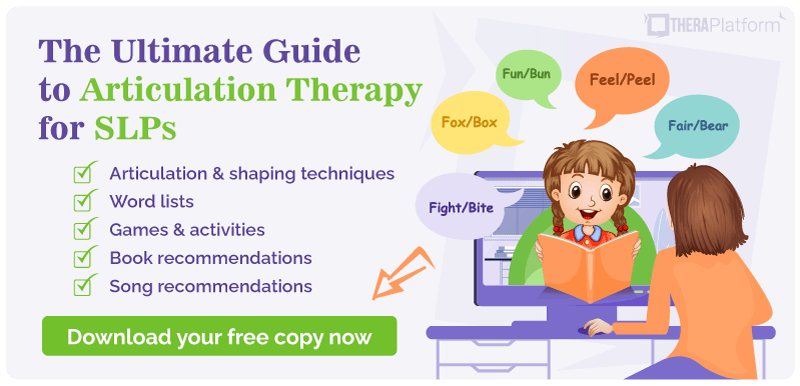J words

‘J’ sounds (which is phonetically transcribed as /dʒ/) can be tricky to work on in Speech Therapy.
Many children struggle to produce this sound, and it typically develops slightly later than some other sounds (by age 4-5, according to developmental norms). If a child is older than 5 and is still having difficulty producing the /j/ sound, it could be time to start directly addressing it as a goal.
When looking at classifications of speech sounds, /j/ is a voiced palatal glide. That means it’s made with the voice on, with the tongue on the hard palate, with continuous airflow through the mouth. Phew! Sounds complex, doesn’t it?
There are a few errors that children commonly make when trying to produce the /j/ sound, such as using the phonological processes:
- Stopping: substituting /j/ with a stopped sound, like /d/ (as in saying “dump” for “jump”)
- Deaffrication: substituting /j/ with a non-affricate sound, like /z/ (as in saying “zoose” for “juice”)
So how can we as SLPs help a child learn how to make the /j/ sound?
Specific verbal, visual, and tactile cues can help, as well as starting with production of the sound in isolation. Because it’s a more complex sound, you may need some extra tips and tricks in your SLP toolbox when addressing this sound in therapy.
Here are some of the best activities and techniques for teaching the /j/ sound. We’ve also got a word list at the end of /j/ words, organized from simple to complex, and in all word positions!
Exercise #1: Use Peanut Butter to Help with Tongue Positioning
Two steps are involved in producing the /j/ sound.
First, with lips rounded as if making the “ch” sound, the tongue comes up to touch the hard palate. Help the child find where this spot is located by putting a small amount of peanut butter on it. Ask the child to lift up their tongue to reach the peanut butter on the roof of their mouth.
Once the child is able to successfully touch their hard palate with their tongue, he or she is ready for the next step.
Step two of making the /j/ sound is to quickly release the tongue from its elevated position, relax the lips and jaw, and quickly produce a burst of air through the mouth.
Another tip: if the child cannot have peanut butter, try another option like having him or her hold a Cheerio to the roof of their mouth with their tongue!
Exercise #2: Feel the Vocal Cord Vibrations
Here’s another method to help a child produce the /j/ sound. Since the /ch/ sound is made with the mouth and tongue in the same position, moving the same way, as /j/, start with that!
To shape /j/ sounds from /ch/, first ask the child to make the /ch/ sound. If he or she is able to make the /ch/ sound, then ask him or her to turn on their voice. Show the child how when you put your hand on your neck as you say, “ah”, you can actually feel the vibrations of the vocal cords tickling your hand.
Next, ask the child to combine those two things, by saying /ch/ while keeping their voice on. A /j/ sound should come out!
Once the child can make the /j/ sound by itself, see if he or she can put it in the beginning of syllables (“Jah, Jee, Joo, Jie, Jay, Joe”). Continue to move up through the hierarchy of producing the sound in the initial position of words, then the medial and final word positions, as well as in phrases and eventually, sentences.

Download our Ultimate Articulation Guide

Exercise #3: Jump for /j/!
What better /j/ word for a child to be able to say but “jump”!
Setting up a fun activity for a child when working on speech sound articulation can help keep him or her engaged and motivated.
Set up flashcards, pictures, or objects of things starting with the /j/ sound around the room (hint: make some close to each other and some farther for an extra fun challenge!).
Ask the child to try and jump from one to the next, saying “jump” each time. Once he or she reaches the picture, word, or object, it’s time to name it for more practice producing the /j/ sound. Collect them all to put into a basket at the end of the obstacle course!
Exercise #4: Create a Speech Jungle Sensory Bin
Create a jungle-themed sensory bin for a hands-on activity to target the /j/ sound and spark your client’s imagination!
Ask the child to start with a small empty bin or box, and collect some items from nature that might appear in a jungle. Things like leaves, grass, sticks, and rocks are perfect!
Next, the child can find some jungle-themed toys and add them to their sensory bin! Here are some ideas:
- Giraffe
- Jeep
- Gem
- Jaguar
- Jewels
Other toy animals starting with other letters can also be added! Exploring and finding these toys in the sensory bin will give the child plenty of opportunities to practice the /j/ sound as they name them and talk about the jungle that they live in!
Start 30-day Free Trial and explore TheraPlatform. HIPAA Compliant Video and Practice Management Software for Therapists.
Exercise #5: Play Fun Online Activities
If you’re seeing a client over teletherapy, using your screen sharing feature to engage your client in some fun online activities can be a great way to work on the /j/ sound!
Here are a few favorites:
- 5 Little Monkeys Jumping on the Bed
- Kokolingo: A digital platform for articulation therapy
- Jet Ski Addition game
- Jelly Slice game
- Curious George games, PBS kids
These activities provide opportunities for multiple trials of /j/ words within your session, so your client can practice target words often to improve their articulation skills.
Word List for /j/ (/dʒ/)
Initial Position
1-Syllable
Jar | Joy | Jam | Jet | Jaw |
Joke | Jeans | Job | Junk | Just |
Jump | June | Juice | Jog | Jeep |
Gem | Gym |
Multisyllabic
Jungle | Jupiter | Jacket | Journal | Jaguar |
Jelly | Giant | Giraffe | Gingerbread | Giant |
Gigantic | Juggle | Jiggle | January | Jellyfish |
Jellybean | Gymnastics |
Medial Position
Pajamas | Magic | Oranges | Engine | Surgeon |
DJ | Detergent | Soldier | Angel | Changing |
Dangerous | Magician | Pigeon | Refrigerator | Vegetable |
Imagine | Project | Pages | Cages |
Final Position
1-Syllable
Fridge | Cage | Age | Large | Stage |
Huge | Fudge | Edge | Hedge | Bridge |
Badge | Sponge |
Multisyllabic
Cabbage | Garbage | Luggage | Cottage | Baggage |
Bandage | Carriage |
SLPs working with individuals who have an articulation disorder or phonological disorder can utilize TheraPlatform for helpful resources. TheraPlatform provides telehealth for SLPs looking to expand their private practice as well as EHR and practice management. TheraPlatform, an all-in-one EHR, practice management and teletherapy tool was built for therapists to help them save time on admin tasks. They also offer a free trial. No credit card required. Cancel anytime.
More resources
- N words
- R words
- Dysphagia ICD-10
- ICD-10 Dysarthria
- Therapy resources and worksheets
- Therapy private practice courses
- Ultimate teletherapy ebook
- The Ultimate Insurance Billing Guide for Therapists
- The Ultimate Guide to Starting a Private Therapy Practice




